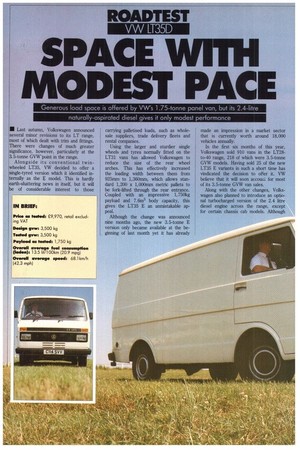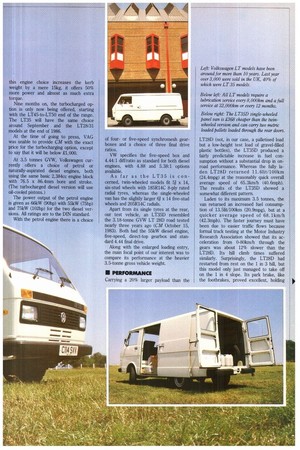PACE Vir
Page 48

Page 49

Page 50

Page 51

If you've noticed an error in this article please click here to report it so we can fix it.
VW LT35D
ODEST PACE
Generous load space is offered by VW's 1.75-tonne panel van, but its 2.4-litre naturally-aspirated diesel gives it only modest performance
III Last autumn, Volkswagen announced several minor revisions to its LT range, ost of which dealt with trim and fittings. ere were changes of much greater ignificance, however, particularly at the .5-tonne GVIV'point in the range. Alongside its conventional twinheeled LT35, VW decided to offer a ngle-tyred version which it identified in ternally as the model. This is hardly earth-shattering news in itself, but it will be of considerable interest to those carrying palletised loads, such as wholesale suppliers, trade delivery fleets and rental companies.
Using the larger and sturdier single wheels and tyres normally fitted on the LT31 vans has allowed Volkswagen to reduce the size of the rear wheel arches. This has effectively increased the loading width between them from 925mm to 1,360mm, which allows standard 1,200 x 1,000mm metric pallets to be fork-lifted through the rear entrance. Coupled with an impressive 1,750kg payload and 7.6m3 body capacity, this gives the LT35 E an unmistakable appeal.
Although the change was announced nine months ago, the new 3.5-tonne E version only became available at the beginning of last month yet it has already made an impression in a market sector that is currently worth around 18,000 vehicles annually.
In the first six months of this year, Volkswagen sold 910 vans in the LT28to-40 range, 218 of which were 3.5-tonne GVW models. Having sold 25 of the new LT35 E variants in such a short time has vindicated the decision to offer it. VW believe that it will soon account for most of its 3.5-tonne GVW van sales.
Along with the other changes, Volkswagen also planned to introduce an optional turbocharged version of the 2.4 litre diesel engine across the range, except for certain chassis cab models. Although this engine choice increases the kerb weight by a mere 15kg, it offers 50% more power and almost as much extra torque.
Nine months on, the turbocharged option is only now being offered, starting with the LT45-to-LT50 end of the range. The LT35 will have the same choice around September and the LT28/31 models at the end of 1986.
At the time of going to press, VAG was unable to provide CM with the exact price for the turbocharging option, except to say that it will be below £1,000.
At 3.5 tonnes GVW, Volkswagen currently offers a choice of petrol or naturally-aspirated diesel engines, both using the same basic 2,384cc engine block with 76.5 x 86.4mm bore and stroke. (The turbocharged diesel version will use oil-cooled pistons.) The power output of the petrol engine is given as 66kW (90hp) with 55kW (75hp) and 75kW (102hp) for the two diesel versions. All ratings are to the DIN standard.
With the petrol engine there is a choice of fouror five-speed synchromesh gearboxes and a choice of three final drive ratios.
VW specifies the five-speed box and 4.44:1 diffiratio as standard for both diesel engines, with 4.88 and 5.38:1 options available.
As far as the LT3 5 is concerned, twin-wheeled models fit 5J x 14, six-stud wheels with 185R14C 8-ply rated radial tyres, whereas the single-wheeled van has the slightly larger 6J x 14 five-stud wheels and 205R14C radials.
Apart from its single tyres at the rear, our test vehicle, an LT35D resembled the 3.18-tonne GVW LT 28D road tested nearly three years ago (CM October 15, 1983). Both had the 55kW diesel engine, five-speed, direct-top gearbox and standard 4.44 final drive.
Along with the enlarged loading entry, the main focal point of our interest was to compare its performance at the heavier 3.5-tonne gross vehicle weight.
• PERFORMANCE
Carrying a 20% larger payload than the LT28D (not, in our case, a palletised load but a low-height test load of gravel-filled plastic bottles), the LT35D produced a fairly predictable increase in fuel consumption without a substantial drop in onroad performance. Whereas the fully laden LT28D returned 11.61it/100km (24.4mpg) at the reasonably quick overall average speed of 65.3km/h (40.6mph). The results of the LT35D showed a somewhat different pattern.
Laden to its maximum 3.5 tonnes, the van returned an increased fuel consumption of 13.51it/100km (20.9mpg), but at a quicker average speed of 68.1km/h (42.3mph). The faster journey must have been due to easier traffic flows because formal track testing at the Motor Industry Research Association showed that its acceleration from 0-80km/h through the gears was about 12% slower than the LT28D. Its hill climb times suffered similarly. Surprisingly, the LT28D had restarted from rest on the 1 in 3 hill, but this model only just managed to take off on the I in 4 slope. Its park brake, like the footbrakes, proved excellent, holding very high, occasionally reaching 86dB(A).
VW insulates the front compartment extremely well in all fairness, with insulated and well shaped rubber floor matting and lined roof trims. Of course, many owners will panel-out the body sides, perhaps even adding a partition behind the driver's compartment. How much this reduces the noise is a matter for speculation, but in its naked condition the levels are high.
VW has recently added, as standard, box-shaped covers to protect the underside from stone-damage. These are in three sections covering the radiator, engine sump and gearbox. While they are of undoubted benefit, they may well be responsible for directing large concentrations of noise upwards which would otherwise be lost externally.
As the centre cover needs removing in order to change the oil filter, they will also extend service times slightly and probably increase charges too.
• MAINTENANCE
Access to the engine oil dipstick is through the flap in the main cover. Topping up can be messy though as the hole in the rocker cover is too low to allow a clean and accurate flow. A lift-up sleeve would simplify the job.
Almost the same could be said of filling the fuel tank, which froths over from the threequarter full point and makes topping up a lengthy operation.
Checking the coolant system reservoir necessitates removing the driver's seat, then the engine cover — straight forward enough jobs, but time consuming and fiddly.
On our test vehicle the single stud which clamps the seat down only had three threads exposed for the nut to grip and looked to be too short. It would not take long on busy rental vehicles before one or more of these threads fretted and weakened the seat clamping arrangement. Under emergency braking this might cause problems.
• HANDLING
The LT35D certainly lived up to our expectations as far as the level of ride performance was concerned. Instead of a pronounced tail-up attitude, when unladen, the semi-eliptic three-leaf springs and rubber buffers help to maintain a fairly even stance whatever the load conditions. Independent wishbones, coil springs and anti-roll bar, plus telescopic dampers all round ensured that the LT35D coped extremely well with MIRA's ride and handling course.
Around the worst of the winding A-road sections of our route the van displayed the same characteristically high standards in both the laden and unladen states. The steering, too, remained light and easy on the driver whatever the load and with an 11.6m kerb-to-kerb turning circle on the short 2.5m wheelbase, makes it a highly manoeuvrable delivery van.
A light clutch pedal should have made gear changing easy too, but the vehicle suffered from decidedly lumpy gear selections that felt very uncertain indeed at the gear lever end.
Several of CM's testers drove the van during the roadtest period and made identical observations.
Another criticism was the handbrake lever being too low and too close to the driver's scat which led to painfu6 damaged finger nails.
Other minor points included the lack of an internal rear view mirror and a handle on the A-post to help the driver into his seat. On the credit side the 3. 5-tonner's cab has comfortable seats, offers all-round visibility and as an open panel van, is very spacious at the front
• SUMMARY
Although a little bit pricey at £9,970, the boxy LT35D with its single-wheel rear axle has a lot to offer and fully deserves its niche in the 3.5-tonne van market.
For such a short 2.5m wheelbase, its 1.75-tonne payload (including the driver) and 7.6m3 cube space is attractive enough but operators with a need to handle one or two palletised loads might well decide to look closer at the LT35D.
The LT35D has a high floor-height, but it is easy to load, with full width opening rear doors and good side access too.
It handles well and, although thirstier than the LT280, it is a fairly fuel-efficient performer at 3.5 tonnes GVW. Perhaps the turbocharged diesel option will add more sparkle to its performance.
There are larger, more voluminous models on the market, as shown in the on the 1 in 4 and facing down the 1 in 3.
The most recent 3.5 tonne tested by CM was Mercedes-Benz's 53kW dieselengined 307D, a high-roof panel van on a much longer 3.35m wheel base. Whereas its acceleration figures were about identical to the LT28D, its test route performance was slightly inferior to the LT35D, but this could well be attributed to the 307D's 365mm taller profile.
The Mercedes-Benz van covered the route at a 671anth (41.6mph) average speed for a 14.31it/1001on (19.7mpg) fuel return.
Like a number of other 3.5-tonne vans, the 3071) can also accommodate metric pallets. Unladen, both returned relatively similar figures with 12.01it/100km (23.5nipg) for the LT35I) and 12.4 lit/100km (22.7mpg) for the M-Benz.
One of the characteristics of smaller diesel engines is that they are fairly high revving units. In the case of the VW 2.5litre motor it was very much a case of pitching the high revs with the gear changes in order to accelerate on gradients or on occasions even to maintain road speeds.
On steep slopes this condition exposed a large gap between second and third gear ratios which needed very high engine revs to overcome, and to a lesser extent between third and fourth where road speeds of well over 64km/h (40mph) were needed to avoid the lack of torque lower down the rev range. An indication of engine speed would be of greater help to any driver in obtaining optimum results.
• CAB COMFORT While the gearing might help towards better fuel efficiency it would undoubtedly do nothing towards reducing the engine transmission and road noise levels inside the unlined panel van body which at speeds of 96km/h (60mph) and more are bar charts. The LT35D's price tag pushes the van to the wrong end of the scale, but most like vans will be hard pressed to better it and prospective van buyers should certainly not ignore it.
by Bryan Jarvis




























































































